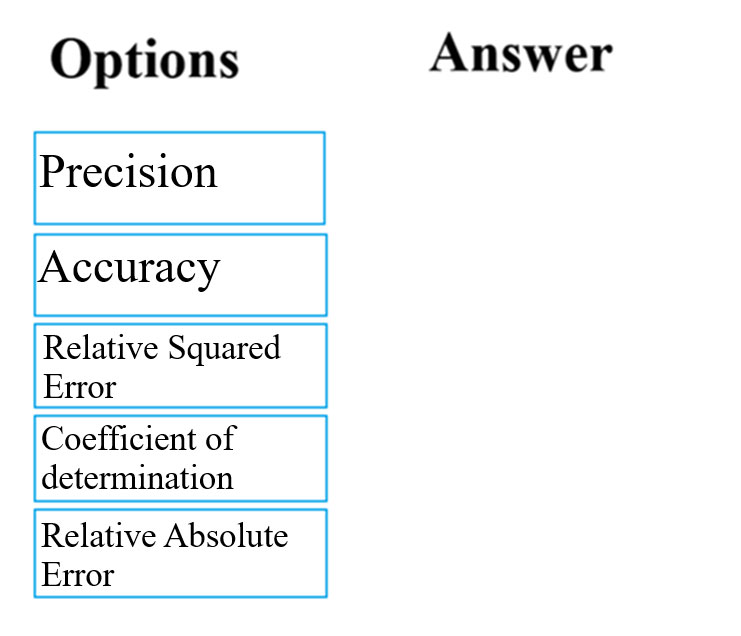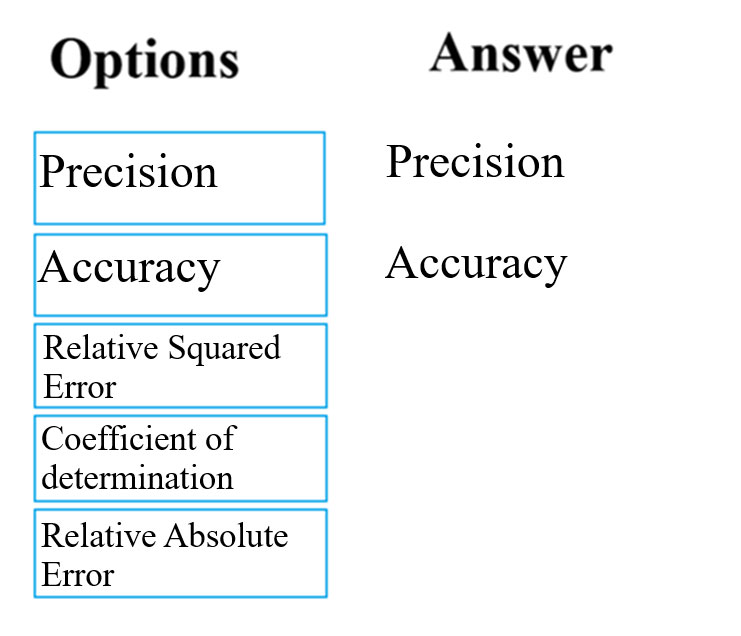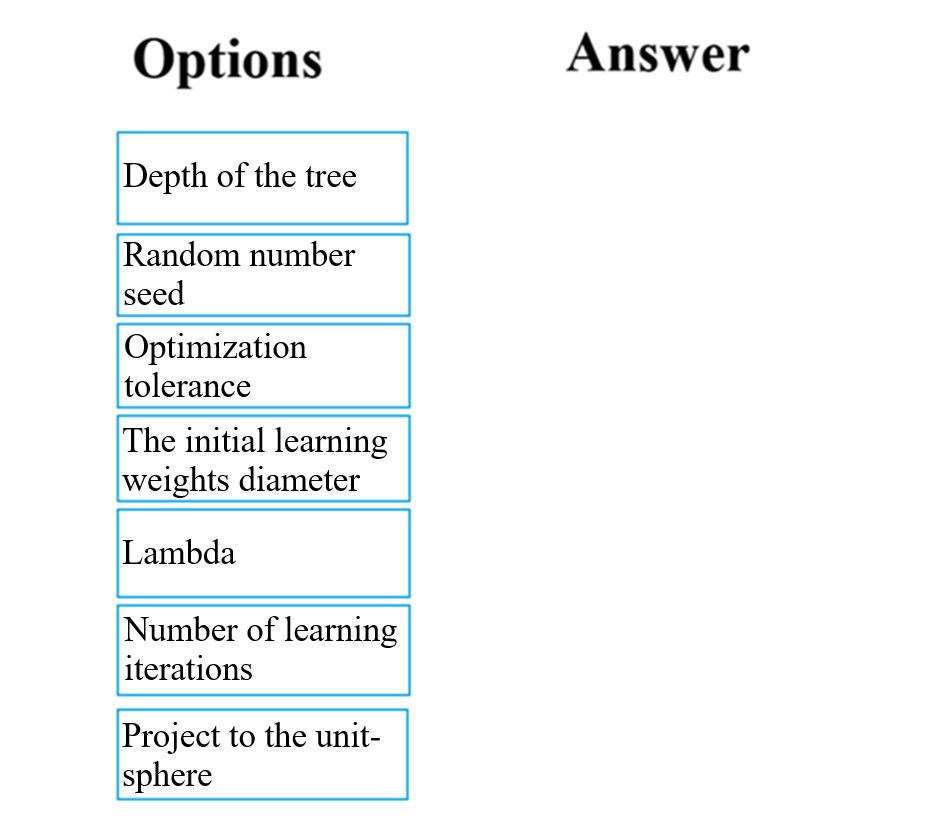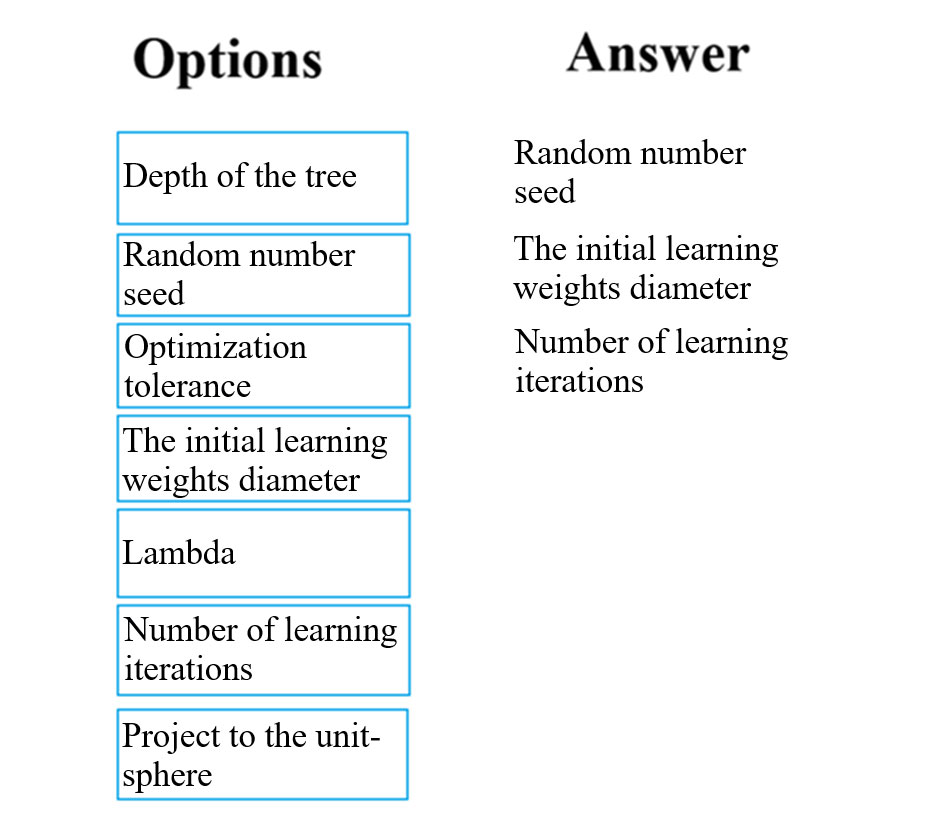Microsoft DP-100 Exam Practice Questions (P. 4)
- Full Access (528 questions)
- Six months of Premium Access
- Access to one million comments
- Seamless ChatGPT Integration
- Ability to download PDF files
- Anki Flashcard files for revision
- No Captcha & No AdSense
- Advanced Exam Configuration
Question #31
You make use of Azure Machine Learning Studio to develop a linear regression model. You perform an experiment to assess various algorithms.
Which of the following is an algorithm that reduces the variances between actual and predicted values?
Which of the following is an algorithm that reduces the variances between actual and predicted values?
- AFast Forest Quantile Regression
- BPoisson Regression
- CBoosted Decision Tree Regression
- DLinear RegressionMost Voted
Correct Answer:
C
Mean absolute error (MAE) measures how close the predictions are to the actual outcomes; thus, a lower score is better.
Reference:
https://docs.microsoft.com/en-us/azure/machine-learning/algorithm-module-reference/boosted-decision-tree-regression https://docs.microsoft.com/en-us/azure/machine-learning/studio-module-reference/evaluate-model https://docs.microsoft.com/en-us/azure/machine-learning/studio-module-reference/linear-regression
C
Mean absolute error (MAE) measures how close the predictions are to the actual outcomes; thus, a lower score is better.
Reference:
https://docs.microsoft.com/en-us/azure/machine-learning/algorithm-module-reference/boosted-decision-tree-regression https://docs.microsoft.com/en-us/azure/machine-learning/studio-module-reference/evaluate-model https://docs.microsoft.com/en-us/azure/machine-learning/studio-module-reference/linear-regression
send
light_mode
delete
Question #32
This question is included in a number of questions that depicts the identical set-up. However, every question has a distinctive result. Establish if the recommendation satisfies the requirements.
You have been tasked with constructing a machine learning model that translates language text into a different language text.
The machine learning model must be constructed and trained to learn the sequence of the.
Recommendation: You make use of Convolutional Neural Networks (CNNs).
Will the requirements be satisfied?
You have been tasked with constructing a machine learning model that translates language text into a different language text.
The machine learning model must be constructed and trained to learn the sequence of the.
Recommendation: You make use of Convolutional Neural Networks (CNNs).
Will the requirements be satisfied?
- AYes
- BNoMost Voted
Correct Answer:
B
B
 GPT-4o - Answer
GPT-4o - Answer
For constructing a machine learning model aimed at translating text from one language to another, Convolutional Neural Networks (CNNs) are not the optimal choice. This is because CNNs are primarily effective for handling static, grid-like data, such as images. In contrast, language translation requires recognizing and generating sequential data, where the order and context of words are crucial. Therefore, architectures like Recurrent Neural Networks (RNNs) or the more modern Transformer models, which are designed to handle sequential data and capture temporal dynamics, would be more appropriate for such tasks.
send
light_mode
delete
Question #33
This question is included in a number of questions that depicts the identical set-up. However, every question has a distinctive result. Establish if the recommendation satisfies the requirements.
You have been tasked with constructing a machine learning model that translates language text into a different language text.
The machine learning model must be constructed and trained to learn the sequence of the.
Recommendation: You make use of Generative Adversarial Networks (GANs).
Will the requirements be satisfied?
You have been tasked with constructing a machine learning model that translates language text into a different language text.
The machine learning model must be constructed and trained to learn the sequence of the.
Recommendation: You make use of Generative Adversarial Networks (GANs).
Will the requirements be satisfied?
- AYes
- BNoMost Voted
Correct Answer:
B
B
 GPT-4o - Answer
GPT-4o - Answer
Absolutely, the recommendation to use Generative Adversarial Networks (GANs) doesn't hit the mark for translating text. GANs shine in generating new, synthetic data, particularly in the domains of images, videos, and voices. However, when it comes to language translation, technologies like Recurrent Neural Networks (RNNs) or, better yet, Transformers are the top choices due to their ability to handle sequences and context in text effectively. GANs simply aren't built to handle the sequence-dependent complexities of language. So, for a machine learning model that translates text between languages, steering clear of GANs is a wise choice.
send
light_mode
delete
Question #34
This question is included in a number of questions that depicts the identical set-up. However, every question has a distinctive result. Establish if the recommendation satisfies the requirements.
You have been tasked with constructing a machine learning model that translates language text into a different language text.
The machine learning model must be constructed and trained to learn the sequence of the.
Recommendation: You make use of Recurrent Neural Networks (RNNs).
Will the requirements be satisfied?
You have been tasked with constructing a machine learning model that translates language text into a different language text.
The machine learning model must be constructed and trained to learn the sequence of the.
Recommendation: You make use of Recurrent Neural Networks (RNNs).
Will the requirements be satisfied?
- AYesMost Voted
- BNo
Correct Answer:
A
Note: RNNs are designed to take sequences of text as inputs or return sequences of text as outputs, or both. They're called recurrent because the network's hidden layers have a loop in which the output and cell state from each time step become inputs at the next time step. This recurrence serves as a form of memory.
It allows contextual information to flow through the network so that relevant outputs from previous time steps can be applied to network operations at the current time step.
Reference:
https://towardsdatascience.com/language-translation-with-rnns-d84d43b40571
A
Note: RNNs are designed to take sequences of text as inputs or return sequences of text as outputs, or both. They're called recurrent because the network's hidden layers have a loop in which the output and cell state from each time step become inputs at the next time step. This recurrence serves as a form of memory.
It allows contextual information to flow through the network so that relevant outputs from previous time steps can be applied to network operations at the current time step.
Reference:
https://towardsdatascience.com/language-translation-with-rnns-d84d43b40571
send
light_mode
delete
Question #35
DRAG DROP -
You have been tasked with evaluating the performance of a binary classification model that you created.
You need to choose evaluation metrics to achieve your goal.
Which of the following are the metrics you would choose? Answer by dragging the correct options from the list to the answer area.
Select and Place:

You have been tasked with evaluating the performance of a binary classification model that you created.
You need to choose evaluation metrics to achieve your goal.
Which of the following are the metrics you would choose? Answer by dragging the correct options from the list to the answer area.
Select and Place:

Correct Answer:

The evaluation metrics available for binary classification models are: Accuracy, Precision, Recall, F1 Score, and AUC.
Note: A very natural question is: 'Out of the individuals whom the model, how many were classified correctly (TP)?'
This question can be answered by looking at the Precision of the model, which is the proportion of positives that are classified correctly.
Reference:
https://docs.microsoft.com/en-us/azure/machine-learning/studio/evaluate-model-performance

The evaluation metrics available for binary classification models are: Accuracy, Precision, Recall, F1 Score, and AUC.
Note: A very natural question is: 'Out of the individuals whom the model, how many were classified correctly (TP)?'
This question can be answered by looking at the Precision of the model, which is the proportion of positives that are classified correctly.
Reference:
https://docs.microsoft.com/en-us/azure/machine-learning/studio/evaluate-model-performance
send
light_mode
delete
Question #36
DRAG DROP -
You build a binary classification model using the Azure Machine Learning Studio Two-Class Neural Network module.
You are preparing to configure the Tune Model Hyperparameters module for the purpose of tuning accuracy for the model.
Which of the following are valid parameters for the Two-Class Neural Network module? Answer by dragging the correct options from the list to the answer area.
Select and Place:

You build a binary classification model using the Azure Machine Learning Studio Two-Class Neural Network module.
You are preparing to configure the Tune Model Hyperparameters module for the purpose of tuning accuracy for the model.
Which of the following are valid parameters for the Two-Class Neural Network module? Answer by dragging the correct options from the list to the answer area.
Select and Place:

Correct Answer:

Reference:
https://docs.microsoft.com/en-us/azure/machine-learning/studio-module-reference/two-class-neural-network

Reference:
https://docs.microsoft.com/en-us/azure/machine-learning/studio-module-reference/two-class-neural-network
send
light_mode
delete
Question #37
You make use of Azure Machine Learning Studio to create a binary classification model.
You are preparing to carry out a parameter sweep of the model to tune hyperparameters. You have to make sure that the sweep allows for every possible combination of hyperparameters to be iterated. Also, the computing resources needed to carry out the sweep must be reduced.
Which of the following actions should you take?
You are preparing to carry out a parameter sweep of the model to tune hyperparameters. You have to make sure that the sweep allows for every possible combination of hyperparameters to be iterated. Also, the computing resources needed to carry out the sweep must be reduced.
Which of the following actions should you take?
- AYou should consider making use of the Selective grid sweep mode.
- BYou should consider making use of the Measured grid sweep mode.
- CYou should consider making use of the Entire grid sweep mode.
- DYou should consider making use of the Random grid sweep mode.Most Voted
Correct Answer:
D
Maximum number of runs on random grid: This option also controls the number of iterations over a random sampling of parameter values, but the values are not generated randomly from the specified range; instead, a matrix is created of all possible combinations of parameter values and a random sampling is taken over the matrix. This method is more efficient and less prone to regional oversampling or undersampling.
If you are training a model that supports an integrated parameter sweep, you can also set a range of seed values to use and iterate over the random seeds as well. This is optional, but can be useful for avoiding bias introduced by seed selection.
C: Entire grid: When you select this option, the module loops over a grid predefined by the system, to try different combinations and identify the best learner. This option is useful for cases where you don't know what the best parameter settings might be and want to try all possible combination of values.
Reference:
https://docs.microsoft.com/en-us/azure/machine-learning/studio-module-reference/tune-model-hyperparameters
D
Maximum number of runs on random grid: This option also controls the number of iterations over a random sampling of parameter values, but the values are not generated randomly from the specified range; instead, a matrix is created of all possible combinations of parameter values and a random sampling is taken over the matrix. This method is more efficient and less prone to regional oversampling or undersampling.
If you are training a model that supports an integrated parameter sweep, you can also set a range of seed values to use and iterate over the random seeds as well. This is optional, but can be useful for avoiding bias introduced by seed selection.
C: Entire grid: When you select this option, the module loops over a grid predefined by the system, to try different combinations and identify the best learner. This option is useful for cases where you don't know what the best parameter settings might be and want to try all possible combination of values.
Reference:
https://docs.microsoft.com/en-us/azure/machine-learning/studio-module-reference/tune-model-hyperparameters
send
light_mode
delete
Question #38
You are in the process of constructing a deep convolutional neural network (CNN). The CNN will be used for image classification.
You notice that the CNN model you constructed displays hints of overfitting.
You want to make sure that overfitting is minimized, and that the model is converged to an optimal fit.
Which of the following is TRUE with regards to achieving your goal?
You notice that the CNN model you constructed displays hints of overfitting.
You want to make sure that overfitting is minimized, and that the model is converged to an optimal fit.
Which of the following is TRUE with regards to achieving your goal?
- AYou have to add an additional dense layer with 512 input units, and reduce the amount of training data.
- BYou have to add L1/L2 regularization, and reduce the amount of training data.
- CYou have to reduce the amount of training data and make use of training data augmentation.
- DYou have to add L1/L2 regularization, and make use of training data augmentation.Most Voted
- EYou have to add an additional dense layer with 512 input units, and add L1/L2 regularization.
Correct Answer:
B
B: Weight regularization provides an approach to reduce the overfitting of a deep learning neural network model on the training data and improve the performance of the model on new data, such as the holdout test set.
Keras provides a weight regularization API that allows you to add a penalty for weight size to the loss function.
Three different regularizer instances are provided; they are:
✑ L1: Sum of the absolute weights.
✑ L2: Sum of the squared weights.
✑ L1L2: Sum of the absolute and the squared weights.
Because a fully connected layer occupies most of the parameters, it is prone to overfitting. One method to reduce overfitting is dropout. At each training stage, individual nodes are either "dropped out" of the net with probability 1-p or kept with probability p, so that a reduced network is left; incoming and outgoing edges to a dropped-out node are also removed.
By avoiding training all nodes on all training data, dropout decreases overfitting.
Reference:
https://machinelearningmastery.com/how-to-reduce-overfitting-in-deep-learning-with-weight-regularization/ https://en.wikipedia.org/wiki/Convolutional_neural_network
B
B: Weight regularization provides an approach to reduce the overfitting of a deep learning neural network model on the training data and improve the performance of the model on new data, such as the holdout test set.
Keras provides a weight regularization API that allows you to add a penalty for weight size to the loss function.
Three different regularizer instances are provided; they are:
✑ L1: Sum of the absolute weights.
✑ L2: Sum of the squared weights.
✑ L1L2: Sum of the absolute and the squared weights.
Because a fully connected layer occupies most of the parameters, it is prone to overfitting. One method to reduce overfitting is dropout. At each training stage, individual nodes are either "dropped out" of the net with probability 1-p or kept with probability p, so that a reduced network is left; incoming and outgoing edges to a dropped-out node are also removed.
By avoiding training all nodes on all training data, dropout decreases overfitting.
Reference:
https://machinelearningmastery.com/how-to-reduce-overfitting-in-deep-learning-with-weight-regularization/ https://en.wikipedia.org/wiki/Convolutional_neural_network
send
light_mode
delete
Question #39
This question is included in a number of questions that depicts the identical set-up. However, every question has a distinctive result. Establish if the recommendation satisfies the requirements.
You are planning to make use of Azure Machine Learning designer to train models.
You need choose a suitable compute type.
Recommendation: You choose Attached compute.
Will the requirements be satisfied?
You are planning to make use of Azure Machine Learning designer to train models.
You need choose a suitable compute type.
Recommendation: You choose Attached compute.
Will the requirements be satisfied?
- AYesMost Voted
- BNo
Correct Answer:
B
Reference:
https://docs.microsoft.com/en-us/azure/machine-learning/how-to-create-attach-compute-studio
B
Reference:
https://docs.microsoft.com/en-us/azure/machine-learning/how-to-create-attach-compute-studio
send
light_mode
delete
Question #40
This question is included in a number of questions that depicts the identical set-up. However, every question has a distinctive result. Establish if the recommendation satisfies the requirements.
You are planning to make use of Azure Machine Learning designer to train models.
You need choose a suitable compute type.
Recommendation: You choose Inference cluster.
Will the requirements be satisfied?
You are planning to make use of Azure Machine Learning designer to train models.
You need choose a suitable compute type.
Recommendation: You choose Inference cluster.
Will the requirements be satisfied?
- AYes
- BNoMost Voted
Correct Answer:
B
Reference:
https://docs.microsoft.com/en-us/azure/machine-learning/how-to-create-attach-compute-studio
B
Reference:
https://docs.microsoft.com/en-us/azure/machine-learning/how-to-create-attach-compute-studio
send
light_mode
delete
All Pages
